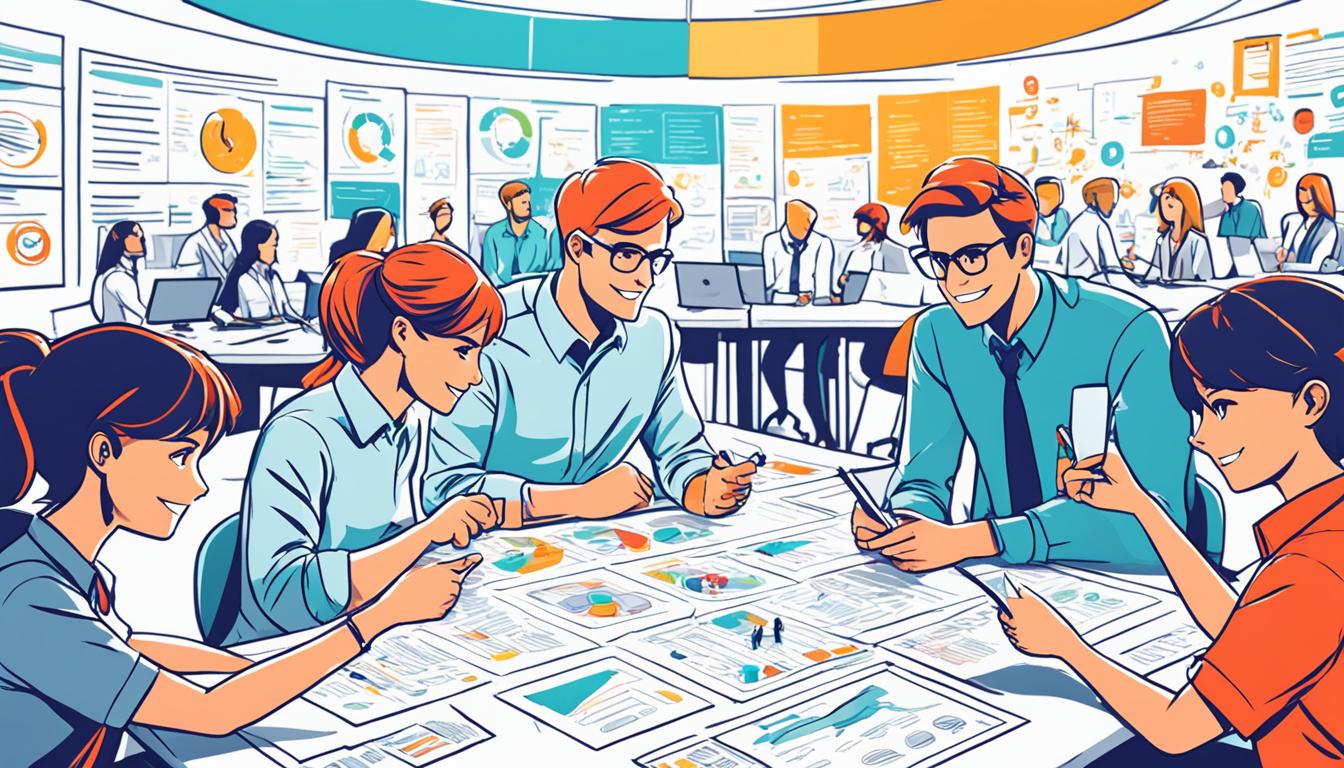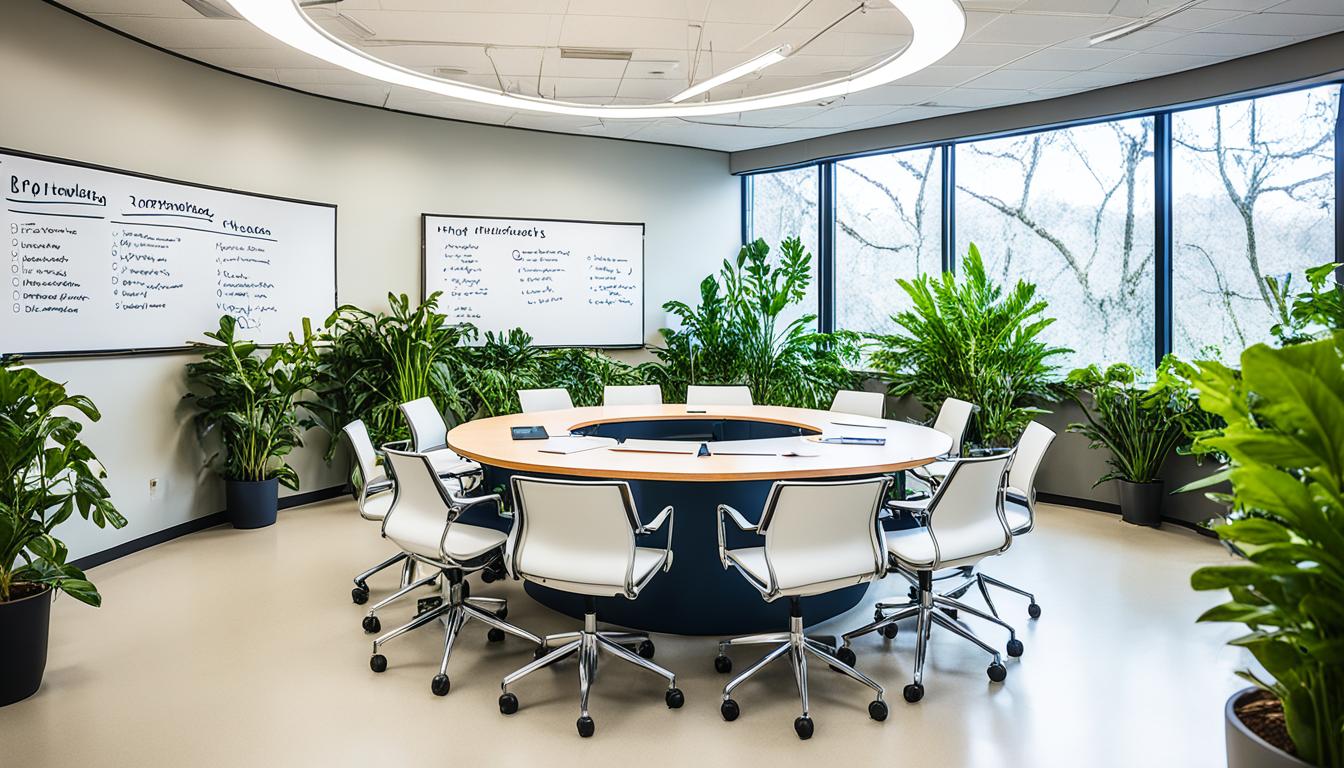
“10 Quick Tips to Transform Your Meetings into Productive Powerhouses””

“The successful warrior is the average man, with laser-like focus.” – Bruce Lee
Meetings. They can be either a catalyst for collaboration and innovation or a complete productivity drain. As the global economy loses a staggering $1.3 trillion each year due to unproductive meetings, it’s clear that something needs to change. The key to transforming your meetings lies in unleashing the power of effective meeting strategies that boost meeting productivity, enhance meeting efficiency, and improve meeting effectiveness.
From the likes of industry leaders like Spotify, Atlassian, and Netflix, we can learn valuable lessons on how to make our meetings work for us. By implementing these proven tactics, you can turn your meetings into productive powerhouses that drive meaningful outcomes and propel your organization forward.
In this article, we will explore 10 quick tips to transform your meetings, providing you with a roadmap to successful meeting practices. So, let’s dive in and unlock the potential of your meetings.
Key Takeaways
- Define the purpose and objectives of each meeting to keep the discussion focused and productive.
- Create a detailed agenda that outlines the topics to be covered and allocates time for each agenda item.
- Optimize meeting durations by choosing unconventional time frames to encourage focused discussions.
- Keep meeting sizes small to facilitate effective collaboration and participation.
- Facilitate check-ins and outline next steps to ensure actionable outcomes are achieved.
Focus on the Purpose of Your Meetings
The first step in transforming meetings into productive powerhouses is to clearly define the purpose of each meeting. By defining the meeting purpose, you can set specific objectives and clarify the goals that need to be achieved. This clarity helps to keep participants focused and ensures that the discussion remains productive.
Set Meeting Objectives
Before any meeting takes place, it’s essential to determine what you hope to accomplish. This involves setting specific objectives that outline the desired outcomes of the meeting. By clearly defining these objectives, you provide a clear direction for the discussion and enable participants to align their efforts towards a common goal.
Clarify Meeting Goals
In addition to setting meeting objectives, it’s important to clarify the goals that need to be achieved. These goals should be specific, measurable, achievable, relevant, and time-bound (SMART). Clear goals provide a framework for decision-making and guide the discussion towards meaningful outcomes.
“A meeting without a clear purpose is just a gathering of individuals.”
– Richard Branson
Benefits of Defining Meeting Purpose
Defining the purpose of your meetings brings several benefits:
- Increased focus: Participants know exactly what needs to be achieved and can direct their efforts accordingly.
- Efficient use of time: When everyone is aligned on the meeting purpose, discussions stay on track and avoid unnecessary tangents.
- Engaged participation: With a clear purpose in mind, participants are more likely to actively contribute and share valuable insights.
- Measurable outcomes: By setting specific objectives and goals, you can evaluate the success of the meeting and track progress towards desired outcomes.
Visualizing the Meeting Purpose
Having a visual reminder of the meeting purpose can be a helpful tool. Consider creating a visual chart or infographic that highlights the objectives, goals, and desired outcomes of the meeting. Displaying this visual in the meeting room can serve as a constant reminder and keep participants focused on the tasks at hand.
Create a Detailed Agenda
A comprehensive agenda is essential for a productive meeting. It provides a roadmap for the discussion, outlines the topics to be covered, and allocates a specific amount of time for each agenda item. A detailed agenda helps keep the meeting on track and ensures that all necessary topics are addressed within the allotted time frame.
“A meeting without an agenda is like a journey without a map.”
Having a clear and well-structured meeting agenda is crucial in maximizing productivity. It sets the expectations for the meeting and helps participants prepare adequately. Without a proper agenda, meetings can go off track, important topics can be missed, and valuable time can be wasted.
Here are some key elements to consider when creating a detailed agenda:
- Identify the meeting objectives: Clearly define the purpose and desired outcomes of the meeting. This will help guide the discussion and ensure that everyone is on the same page.
- List the agenda items: Break down the main topics that need to be addressed during the meeting. Be specific and concise with each agenda item to avoid confusion.
- Allocate time for each agenda item: Determine how much time should be spent on each agenda item. Consider the importance and complexity of the topic and allocate time accordingly. This ensures that all topics are covered within the given timeframe.
- Order the agenda items: Arrange the agenda items in a logical order. Start with the most important or time-sensitive topics to ensure they receive sufficient attention.
- Include any necessary materials: If there are any documents, reports, or presentations that participants need to review before the meeting, include them as attachments or provide links for easy access.
By following these steps and creating a detailed agenda, you can effectively manage the flow of the meeting, keep discussions focused, and ensure that all relevant topics are addressed. A well-structured agenda sets the foundation for a successful and productive meeting.
Benefits of a Detailed Agenda
A comprehensive agenda offers several benefits:
- Clarity and focus: Participants have a clear understanding of the meeting’s purpose and the topics that will be discussed, promoting focused discussions and minimizing tangents.
- Time management: By allocating specific time for each agenda item, the meeting stays on track and avoids unnecessary time spent on less important topics.
- Efficiency: A well-planned agenda eliminates confusion and allows participants to come prepared, ensuring that discussions are productive and decisions can be made efficiently.
- Accountability: The agenda serves as a reference for follow-up actions and responsibilities. It helps ensure that tasks and decisions made during the meeting are properly documented and assigned.
Creating a detailed agenda is an investment of time that yields significant returns in terms of meeting productivity. It sets the stage for a successful discussion, keeps participants engaged, and maximizes the value of every meeting.
Optimize Meeting Durations
Traditional meeting durations often result in wasted time and unproductive discussions. To combat this, consider adopting unconventional meeting durations that can help maximize efficiency and overcome Parkinson’s Law. Rather than sticking to the usual half-hour or hour-long meetings, try scheduling sessions for 25 or 50 minutes. This approach forces participants to stay focused and make the most of the limited time available.
By implementing shorter meeting times, you create a sense of urgency and encourage participants to prioritize the most important discussions. This prevents unnecessary tangents and promotes concise communication, leading to more productive outcomes.
“The shorter format of meetings enables a more focused and results-oriented discussion.”
Overcoming Parkinson’s Law, which suggests that work expands to fill the time allocated, is another benefit of optimizing meeting durations. With less time available, participants are prompted to utilize their time effectively and stay on track.
Consider this visual illustration of the impact of unconventional meeting durations on productivity:
| Traditional Meeting Durations | Unconventional Meeting Durations |
|---|---|
| Longer meetings often result in unnecessary discussions and time wasted on tangents. | Shorter meetings promote focused and concise discussions, minimizing distractions and maximizing productivity. |
| Participants may struggle to stay engaged and focused throughout the entire duration of the meeting. | By optimizing meeting durations, participants maintain a high level of engagement and focus due to the time constraints. |
| Meetings tend to run over the allocated time, affecting schedules and causing delays for subsequent tasks. | Shorter meetings ensure better time management and allow participants to adhere to their schedules, improving overall efficiency. |
Optimizing meeting durations is a simple yet effective strategy for enhancing productivity and ensuring that discussions remain focused on the most critical topics. By challenging the norm and embracing shorter meeting times, you can overcome Parkinson’s Law and make the most of valuable time.
Keep Meeting Size Small
One key factor in maintaining productivity during meetings is to keep the meeting size small. By limiting the number of attendees to only those who are necessary, you can ensure a more focused and efficient discussion. With a smaller group, each individual has a better opportunity to participate and collaborate effectively.
Smaller meetings enable more meaningful interactions and allow for a deeper level of engagement from all participants. By excluding unnecessary attendees, you can eliminate distractions and stay on track with the agenda, making it easier to achieve the goals of the meeting.
Furthermore, small meeting sizes promote a sense of responsibility and accountability among participants. When individuals are aware that their presence is vital to the meeting’s success, they are more likely to actively contribute and engage in a productive discussion.
Consider implementing this practice when organizing your meetings to ensure that the right people are involved and that the discussion remains focused, resulting in more efficient and effective outcomes.
“With a smaller group, you are more likely to have focused, effective discussions where everyone can contribute meaningfully.”
Facilitate Check-Ins and Outline Next Steps
To ensure that your meetings yield actionable outcomes, it is crucial to facilitate check-ins and provide a clear roadmap for next steps. By taking the time to check in with each participant, allowing them to share updates, and assigning action items, follow-up tasks can be completed efficiently, resulting in more purposeful and productive meetings.
Implementing meeting check-ins allows for open communication and ensures that everyone is on the same page. By encouraging participants to share updates, valuable information and insights can be gathered, leading to informed decision-making and progress.
“Check-ins provide an opportunity for individuals to share progress, raise concerns, and collaborate on solutions. It fosters a sense of accountability and drives the momentum of the meeting.”
Additionally, outlining next steps is crucial for maintaining momentum and ensuring that the outcomes of the meeting are translated into tangible actions. By assigning action items and clearly defining responsibilities, participants are empowered to take ownership of their tasks and contribute to the overall progress of the project or initiative.
By incorporating these practices, meetings become more than just a discussion. They become a productive platform for driving results and fostering collaboration.
Sample Check-In Template:
| Participant | Update |
|---|---|
| John | Provided an overview of the market research findings |
| Sarah | Discussed the progress of the marketing campaign |
| Michael | Shared insights from the customer feedback survey |

Note: The above template is just a sample and can be customized based on the specific needs of your meeting.
Establish Agreement and Alignment
Meetings serve as crucial opportunities to align with broader team or organizational goals and foster meaningful discussions that drive positive outcomes. To ensure that your meetings are focused and productive, it is essential to establish agreement and alignment among participants regarding the meeting objectives.
Alignment with organizational goals ensures that discussions remain purposeful and contribute to the overall mission. By clearly communicating the meeting objectives and ensuring that all participants understand and agree with them, you can cultivate a shared sense of purpose and direction.
Meaningful discussions are the result of aligning meeting objectives with strategic goals. When participants are aligned with the broader organizational vision, their contribution becomes more relevant, insightful, and impactful. By creating an environment where everyone understands the big picture, you can foster discussions that are centered around achieving tangible outcomes.
Fostering Alignment
To establish agreement and alignment, consider the following strategies:
- Communicate the meeting objectives: Clearly articulate the purpose of the meeting and the goals that need to be achieved.
- Connect meeting objectives to organizational goals: Demonstrate how the meeting objectives contribute to the larger strategic goals of the team or organization.
- Provide context: Share relevant information and context to help participants understand the importance of the meeting objectives.
- Encourage open dialogue: Facilitate discussions where participants can ask questions, seek clarification, and provide input to ensure everyone is on the same page.
By fostering agreement and alignment, you create a foundation for productive discussions that drive meaningful outcomes. When all participants are aligned with the meeting objectives and understand how they contribute to the broader organizational goals, the discussions become more purposeful, relevant, and engaging.
Ensuring Meaningful Outcomes
Meaningful discussions are not just about reaching agreement; they are about achieving tangible outcomes that move the organization forward. To ensure that your meetings lead to meaningful outcomes, consider the following approaches:
- Strategic prioritization: Prioritize agenda items that are directly aligned with the meeting objectives and have the most significant impact on organizational goals.
- Encourage diverse perspectives: Foster an inclusive environment where diverse viewpoints are valued and contribute to richer discussions and innovative solutions.
- Implement action-oriented follow-up: Assign clear action items and responsibilities to ensure that the discussion leads to concrete results and progress.
By implementing these approaches, you can transform meetings into powerful platforms for driving alignment, meaningful discussions, and tangible outcomes that propel your organization towards its goals.
| Meeting Objectives | Organizational Goals | Alignment | Meaningful Discussions |
|---|---|---|---|
| Clearly communicate the purpose of the meeting | Demonstrate how meeting objectives contribute to strategic goals | Ensure all participants understand and agree with the meeting objectives | Facilitate open dialogue and diverse perspectives |
| Prioritize agenda items aligned with meeting objectives | Encourage an inclusive environment for rich discussions and innovative solutions | Assign clear action items to drive tangible outcomes |
Respect Time and Structure
Respecting time and maintaining a structured approach is essential for meeting efficiency. By adhering to punctuality and honoring allocated time for each agenda item, you can foster focused discussions and prevent wasted time.
Start and end meetings on time to set a precedent for punctual meetings. This demonstrates respect for attendees’ time and creates a sense of urgency and productivity. When meetings start late, it can create a domino effect, leading to delays and decreased overall efficiency.
Stick to the allocated time for each agenda item. Clearly define the time frame for each topic on the agenda and ensure that discussions do not exceed the designated duration. This helps participants stay focused, maintain productivity, and ensure that all necessary topics are covered within the meeting’s timeframe.
“Time isn’t the main thing. It’s the only thing.” – Miles Davis
A structured and punctual meeting leads to increased productivity. When meetings are well-organized and adhere to a predetermined structure, participants know what to expect and can better prepare. They come ready to contribute to the discussion and make decisions, resulting in more efficient and effective meetings.
Remember, time is a valuable resource. By respecting time and embracing structured meetings, you can optimize meeting efficiency and make the most of every discussion.
| Benefits of Respecting Time and Structure in Meetings: |
|---|
| 1. Increased productivity |
| 2. Efficient use of participants’ time |
| 3. Improved focus and engagement |
| 4. Clear expectations and preparation |
| 5. Timely decision-making and action |
Encourage Participation
Active participation from all meeting attendees is crucial for productive discussions. Encouraging everyone to share their thoughts, ask questions, and engage in the conversation fosters an inclusive and collaborative environment. Diverse perspectives lead to more innovative ideas and solutions.
To ensure active participation in your meetings, consider implementing the following strategies:
- Set the stage: Start by creating a welcoming and supportive atmosphere where everyone feels comfortable contributing. Establish ground rules that promote respectful and inclusive discussions.
- Invite diverse perspectives: Encourage attendees from different departments, backgrounds, and levels of seniority to participate. This diversity of thought can provide fresh insights and unique problem-solving approaches.
- Ask open-ended questions: Instead of simply seeking yes or no responses, ask questions that require attendees to share their opinions and ideas. This encourages deeper engagement and fosters more meaningful discussions.
- Listen actively: Show genuine interest in what each participant has to say. Avoid interrupting or dismissing their contributions. Actively listening promotes a sense of value and encourages further participation.
- Facilitate inclusive discussions: Encourage quieter individuals to share their thoughts by specifically asking for their input. Repeat and validate their ideas to ensure their voices are heard.
Remember to acknowledge and appreciate the contributions of all participants. By fostering active participation and inclusive discussions, your meetings will become vibrant platforms for collaborative problem-solving and idea generation.
“When everyone has the opportunity to contribute, the outcome is often greater than the sum of its parts.”
– Katherine Johnson
| Benefits of Active Participation | Actions |
|---|---|
| Enhances creativity and innovation |
|
| Boosts team morale and engagement |
|
| Leads to more effective decision-making |
|
Experiment with Different Meeting Formats
To keep meetings engaging and effective, it is beneficial to experiment with different meeting formats. This can include:
- Hybrid Meetings: Combining in-person and virtual participation to accommodate remote team members and facilitate collaboration across locations. This format allows for increased flexibility and inclusivity in meetings, resulting in more productive discussions.
- Brainstorming Sessions: Designated time for idea generation and creative thinking. By providing a structured environment for brainstorming, participants can freely express their thoughts and contribute to innovative solutions.
- Silent Meetings: A unique approach to collective document review, where participants review and provide feedback on documents independently. This format promotes focused analysis and minimizes distractions, resulting in more comprehensive and thoughtful feedback.
- Outdoor Meetings: Taking advantage of natural surroundings to provide a refreshing change of environment. Walking meetings, for example, can boost creativity, improve overall well-being, and encourage active participation.
Adapting the meeting format to the specific objectives and desired outcomes can enhance productivity and creativity. By exploring different meeting formats, you can discover new strategies to make your meetings more efficient and engaging.
Conclusion
By implementing the 10 quick tips mentioned above and learning from industry leaders like Spotify, Atlassian, and Netflix, you can transform your meetings into productive powerhouses. Clear purpose and detailed agendas help keep the discussion focused and on track, while optimized durations and small meeting sizes ensure efficiency. Facilitating check-ins and outlining next steps lead to actionable outcomes, and aligning meeting objectives with larger goals drives meaningful discussions. Respecting time and encouraging active participation foster a collaborative environment, and experimenting with different meeting formats adds variety and creativity.
With these strategies in place, your meetings can become valuable tools for collaboration, decision-making, and achieving your organizational goals. Productive meetings are a key driver of meeting efficiency, effective collaboration, and the maximization of meeting impact. Embracing these practices will revolutionize your approach to meetings and help you make the most of every interaction.
Transform your meetings today and unleash the full potential of your team.






























